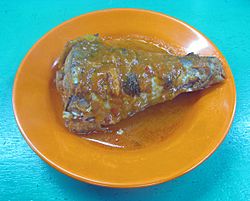Asam pedas facts for kids

Ambu-ambu asam padeh, a Padang-style asam pedas ikan tongkol (mackerel tuna)
|
|
| Course | Main course |
|---|---|
| Place of origin | Indonesia |
| Region or state | Sumatra |
| Associated national cuisine | Indonesia, Malaysia and Singapore |
| Serving temperature | Hot or room temperature |
| Main ingredients | Fish cooked in sour and hot sauce |
Asam pedas (which means "sour and spicy" in the Minangkabau language) is a popular sour and spicy fish stew. It comes from Maritime Southeast Asia. Many people believe it started with the Minangkabau people in West Sumatra, Indonesia.
This tasty dish has spread widely. You can find it across the islands of Sumatra (including Riau, Jambi, South Sumatra), Borneo (West Kalimantan), and the Malay Peninsula.
Where Asam Pedas is Popular
This spicy and sour fish dish is very common in the Malay Archipelago. It is well-known in Sumatra, Borneo, and the Malay Peninsula. Asam pedas is an important part of both Minangkabau and Malay cooking traditions.
You can easily find Minang asam padeh in Padang restaurants. These restaurants are popular in Indonesia, Malaysia, and Singapore.
It has also become a traditional food for Malay people. This includes those from the eastern parts of Sumatra, like Jambi, Riau, and Riau Islands. It's even found as far north as Aceh.
Across the Strait of Malacca, you can find it in Johor, Malacca, and Singapore. It's also popular in coastal Borneo, especially in Pontianak, West Kalimantan. The spices and fish used might be a little different depending on the area.
How Asam Pedas is Made

The main ingredients for asam pedas are usually fish. This can be either seafood or freshwater fish. These fish are cooked in a sour sauce made from asam (tamarind) fruit juice. The sauce also gets its kick from chilli and other spices.
To make the sauce, the soft pulp of the tamarind fruit is soaked. Then, its juice is squeezed out to cook the fish. Sometimes, people use asam paste for an easier way to get the sour flavor.
Vegetables are often added to the stew. Common choices include terong or brinjals (which are a type of eggplant), okra, and tomatoes.
Many kinds of fish and seafood are used. These include mackerel, mackerel tuna, tuna, skipjack tuna, red snapper, gourami, pangasius, hemibagrus, or even cuttlefish. Sometimes, only the fish heads are used to make this spicy and tart fish stew. It's important for the fish to stay whole when served. So, the fish is usually added last during cooking.
In Indonesia, the most common fish used for asam pedas is tongkol (mackerel tuna).
Other countries have similar sour fish dishes. For example, Kaeng som is the Thai version of asam pedas. In Bengal, India, there is a similar dish called Macher tak, which means "sour fish."


